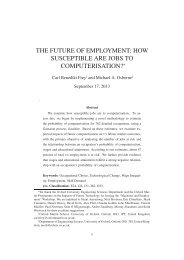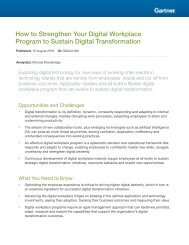THE FUTURE OF EMPLOYMENT: HOW SUSCEPTIBLE ARE JOBS TO COMPUTERIZATION?
We examine how susceptible jobs are to computerization. To assess this, we begin by implementing a novel methodology to estimate the probability of computerization for 702 detailed occupations, using a Gaussian process classifier. Based on these estimates, we examine expected impacts of future computerization on US labor market outcomes, with the primary objective of analyzing the number of jobs at risk and the relationship between an occupation’s probability of computerization, wages and educational attainment. According to our estimates, about 47 percent of total US employment is at risk. We further provide evidence that wages and educational attainment exhibit a strong negative relationship with an occupation’s probability of computerization.
We examine how susceptible jobs are to computerization. To assess this, we begin by implementing a novel methodology to estimate the probability of computerization for 702 detailed occupations, using a Gaussian process classifier. Based on these estimates, we examine expected impacts of future computerization on US labor market outcomes, with the primary objective of analyzing the number of jobs at risk and the relationship between an occupation’s probability of computerization, wages and educational attainment. According to our estimates, about 47 percent of total US employment is at risk. We further provide evidence that wages and educational attainment exhibit a strong negative relationship with an occupation’s probability of computerization.
You also want an ePaper? Increase the reach of your titles
YUMPU automatically turns print PDFs into web optimized ePapers that Google loves.
TABLE I. O∗NET variables that serve as indicators of bottlenecks to computerisation.<br />
Computerisation<br />
bottleneck<br />
Perception<br />
and<br />
Manipulation<br />
Creative<br />
Intelligence<br />
O∗NET Variable<br />
Finger<br />
Dexterity<br />
Manual<br />
Dexterity<br />
Cramped Work Space,<br />
Awkward Positions<br />
Originality<br />
Fine Arts<br />
O∗NET Description<br />
The ability to make precisely coordinated movements of<br />
the fingers of one or both hands to grasp, manipulate, or<br />
assemble very small objects.<br />
The ability to quickly move your hand, your hand together<br />
with your arm, or your two hands to grasp, manipulate, or<br />
assemble objects.<br />
How often does this job require working in cramped work<br />
spaces that requires getting into awkward positions?<br />
The ability to come up with unusual or clever ideas about<br />
a given topic or situation, or to develop creative ways to<br />
solve a problem.<br />
Knowledge of theory and techniques required to compose,<br />
produce, and perform works of music, dance, visual arts,<br />
drama, and sculpture.<br />
Social<br />
Intelligence<br />
Social<br />
Perceptiveness<br />
Being aware of others’ reactions and understanding why<br />
they react as they do.<br />
Negotiation Bringing others together and trying to reconcile<br />
differences.<br />
Persuasion<br />
Assisting and Caring for<br />
Others<br />
Persuading others to change their minds or behavior.<br />
Providing personal assistance, medical attention, emotional<br />
support, or other personal care to others such as<br />
coworkers, customers, or patients.<br />
the level of “Manual Dexterity” computer-controlled equipment would require<br />
to perform a specific occupation. An exception is the “Cramped work space”<br />
variable, which measures the frequency of unstructured work.<br />
Hence, in short, by hand-labelling occupations, we work around the issue<br />
that O∗NET data was not gathered to specifically measure the automatability of<br />
jobs in a similar manner to Blinder (2009). In addition, we mitigate some of the<br />
subjective biases held by the researchers by using objective O∗NET variables to<br />
correct potential hand-labelling errors. The fact that we label only 70 of the full<br />
702 occupations, selecting those occupations whose computerisation label we<br />
are highly confident about, further reduces the risk of subjective bias affecting<br />
our analysis. To develop an algorithm appropriate for this task, we turn to<br />
probabilistic classification.<br />
31





